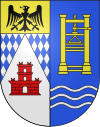Capolago
| Capolago | ||
|---|---|---|
| Village and Quarter | ||
|
||
 |
||
| Country | Switzerland | |
| Canton | Ticino | |
| District | Mendrisio | |
| City | Mendrisio | |
| Area | ||
| • Total | 1.77 km2 (0.68 sq mi) | |
| Population (2011-12-31) | ||
| • Total | 798 | |
| • Density | 450/km2 (1,200/sq mi) | |
Capolago is a village situated at the south-eastern extremity of Lake Lugano, in the Swiss canton of Ticino. Originally a municipality in its own right, Capolago is now a quarter of the municipality of Mendrisio, itself part of the district of Mendrisio.
The first mention of the name of Capolago appears before 1300, in the general statutes of Como. In 1365, Capolago assumed greater importance due to the building of castle. The castle was dismantled in 1517. From then on, the village was largely concerned with fishing, and the ferrying of people and goods to and from Lugano.
In 1556, Capolago was the birthplace of the architect Carlo Maderno. He is best remembered as one of the fathers of Baroque architecture, responsible for the façades of St. Peter's Basilica, Santa Susanna, and Sant'Andrea della Valle, all in Rome.
The construction of the Melide causeway, in 1841, followed by the opening of the local part of the Gotthard Railway, in 1874, saw changes to Capolago. The main road and railway brought better transport connections, but also reduced the need for boat services on the lake. However the opening of the Monte Generoso railway, in 1890, strengthened tourist traffic.
In 1910, the Mendrisio electric tramway opened, linking a northern terminus in Riva San Vitale with Capolago, Mendrisio, Balerna and Chiasso. The section of the line in Capolago closed in 1948 and was replaced by a bus service.
...
Wikipedia

